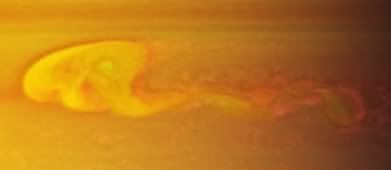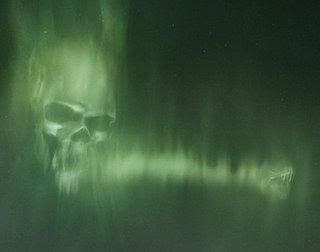Big storm on Saturn |

  |
Big storm on Saturn |
 Dec 30 2010, 02:44 AM Dec 30 2010, 02:44 AM
Post
#31
|
|
 Senior Member     Group: Moderator Posts: 2785 Joined: 10-November 06 From: Pasadena, CA Member No.: 1345 |
Well hot diggity-dawg, that EXCEL file posted above worked!!! One of our local amateur astronomers used it to image Saturn and snagged two timepoints:
http://www.raleighastro.org/gallery/main.php?g2_itemId=4342 -------------------- Some higher resolution images available at my photostream: http://www.flickr.com/photos/31678681@N07/
|
|
|
|
 Dec 30 2010, 03:44 AM Dec 30 2010, 03:44 AM
Post
#32
|
|
 Newbie  Group: Members Posts: 4 Joined: 28-December 10 Member No.: 5587 |
Hi folks! This is my first post to this board. I happen to be fascinated with violent weather on other planets-in particular, thunderstorms. I'm wondering if this is what this particular storm is-one massive thunderhead or a series of them bunched in some sort of titanic squall line. I note that similar massive thunderheads had appeared on Jupiter, supposedly towering 100 miles above the surrounding clouds. Those storms were also very rare. I hope that Cassini can do radio readings to check for lightning bolts. If there are lightning bolts in this storm, it wouldn't surprise me if some of them were strong enough to incinerate a city! Flying alongside this beast would be a truly terrifying and awe-inspiring experience.
Another thought would be to photograph this storm when it's on Saturn's night side to check for lightning flashes. It's too bad we can't do some sort of 3-D representation of this storm, so we could check out is vertical structure. -------------------- "Yes! To you, Baldrick, the Renaissance...was was just something that happened to other people, wasn't it??"
|
|
|
|
 Dec 30 2010, 04:28 AM Dec 30 2010, 04:28 AM
Post
#33
|
|
|
Member    Group: Members Posts: 104 Joined: 1-June 08 Member No.: 4172 |
|
|
|
|
 Dec 31 2010, 04:49 AM Dec 31 2010, 04:49 AM
Post
#34
|
|
 Senior Member     Group: Moderator Posts: 2785 Joined: 10-November 06 From: Pasadena, CA Member No.: 1345 |
Here is my new and improved EXCEL spreadsheet for predicting Saturn storm visibility from Earth. It is based on ground-based observations and starts from Dec 10 and projects forward to Jan 24, 2011. (It correlates to images already acquired between Dec 10 and Dec. 27th.)
Assuming a "System II" cloud rotation rate of 10 h 39 min, the storm is tracking westwards 3 min every Saturn rotation. Effectively the storm is rotating around Saturn every 10 h 42 min as viewed from Earth. The best views will be about 30 minutes or so before the storm is at dead center on Saturn's disk. Enjoy!  Saturn_Storm_spotting_from_Earth__Dec_10_2010___Jan_24_2011__UPDATE_20101230.xls ( 43K )
Number of downloads: 540
Saturn_Storm_spotting_from_Earth__Dec_10_2010___Jan_24_2011__UPDATE_20101230.xls ( 43K )
Number of downloads: 540-------------------- Some higher resolution images available at my photostream: http://www.flickr.com/photos/31678681@N07/
|
|
|
|
 Dec 31 2010, 05:08 AM Dec 31 2010, 05:08 AM
Post
#35
|
||
 Senior Member     Group: Moderator Posts: 2785 Joined: 10-November 06 From: Pasadena, CA Member No.: 1345 |
Saturn in MethanoVision, using RGB[CB2, MT2, CB2xInvert(BL1)] from the December 24th observation:
Neat dark ring around the storm (downwelling, so more methane absorbance?) and some detail of a bright upwelling in the storm center itself. -------------------- Some higher resolution images available at my photostream: http://www.flickr.com/photos/31678681@N07/
|
|
|
|
||
 Dec 31 2010, 05:24 AM Dec 31 2010, 05:24 AM
Post
#36
|
|
 Member    Group: Members Posts: 723 Joined: 13-June 04 Member No.: 82 |
Hmmm...
  Coincidence? |
|
|
|
 Dec 31 2010, 05:35 PM Dec 31 2010, 05:35 PM
Post
#37
|
|
 Senior Member     Group: Moderator Posts: 2785 Joined: 10-November 06 From: Pasadena, CA Member No.: 1345 |
Here is an animated sequence showing storm evolution from ground-based observations from December 14th to December 30, 2010:
http://www.flickr.com/photos/31678681@N07/5309489179/ See also: Link to Trevor Barry's website here: http://trevsastronomy.webs.com/apps/photos...albumid=8090267 Link to Anthony Wesley's website here: http://www.acquerra.com.au/astro/ -------------------- Some higher resolution images available at my photostream: http://www.flickr.com/photos/31678681@N07/
|
|
|
|
 Jan 1 2011, 03:06 PM Jan 1 2011, 03:06 PM
Post
#38
|
|
|
Member    Group: Members Posts: 910 Joined: 4-September 06 From: Boston Member No.: 1102 |
From Rev143 Looking Ahead Cassini should get some more images of the storm between now and Jan 20.
" ISS begins its observations for Rev143 and the new year on January 2 as it performs astrometric observations of Saturn's small, inner moons. During this observation, the camera system will image Polydeuces, Telesto, Pallene, Prometheus, Anthe, and Atlas. Shortly before, the wide-angle camera (WAC) will image Saturn. The large, bright storm that formed in December 2010 in the North Temperate Zone of Saturn should be visible during this observation (though slightly farther to the west than shown in the graphic at right as the storm is slowly drifting to the west by 2.5 degrees per day with respect to the IAU longitude system for Saturn). ISS will take a similar observation on January 6, when the narrow-angle camera (NAC) will observe Prometheus, Anthe, Atlas, Methone, Calypso, Pallene, and Polydeuces. The Saturn WAC images should show the western end of the large northern storm." There will be other images of Saturn on the 10th and 15th, but the storm will not be imaged unless it has expanded significantly. -------------------- |
|
|
|
 Jan 5 2011, 03:43 AM Jan 5 2011, 03:43 AM
Post
#39
|
||
 Senior Member     Group: Moderator Posts: 2785 Joined: 10-November 06 From: Pasadena, CA Member No.: 1345 |
Blink animation of Dec 24 and Jan 2 in MethanoVision. The new spot to the E looks "fresher" (more white = less methane absorbance = higher cloudtops). This suggests a hot spot plume from a deeper atmospheric layer and the older storm lobes being carried westward?
[Animated GIF: click to animate] The MethanoVision Jan 2 image can be seen here: http://www.flickr.com/photos/31678681@N07/...in/photostream/ -------------------- Some higher resolution images available at my photostream: http://www.flickr.com/photos/31678681@N07/
|
|
|
|
||
 Jan 5 2011, 05:27 AM Jan 5 2011, 05:27 AM
Post
#40
|
|
|
Newbie  Group: Members Posts: 14 Joined: 3-January 11 From: Pasadena, CA Member No.: 5592 |
It would certainly be simpler, but nothing in spacecraft operations is simple. There would still be numerous issues to be resolved- what pre-planned observations would be displaced, where would the data be put and when would they be downloaded, thermal implications of the new scan platform orientation would have to be checked, and new command sequences would have to be developed and tested. The Mars Rovers are always responding to new information on ~24 hour timescales, but they and their operations are designed from the ground up to be able to do that. Orbital missions are never that flexible. John Ah! Finally, someone gets it. I am part of the tactical uplink operations and engineering team for the Rovers, and I'm glad to see that it's understood how different these things can be! Based on the little I know about Cassini (I've never been acquainted with its sequencing process either, other than its pointing design and control suite for attitude constraints), I would guess that having a scan platform has just as many pros as cons. The pros would obviously include increased science -- you no longer have to move the whole spacecraft -- and maybe reduced usage of the reaction wheels. Would be tough to say without a high-fidelity analysis there. The cons would be adding more analyses and sequence flight rule checks for the operations team, and wear and tear for the engineering team. No such thing as a free lunch. In any case... pretty pics! -------------------- "There's no Launch Checklist Step 4a: 'Pause and reflect on the enormity of what happens next'."
|
|
|
|
 Jan 5 2011, 10:57 AM Jan 5 2011, 10:57 AM
Post
#41
|
||
|
Member    Group: Members Posts: 910 Joined: 4-September 06 From: Boston Member No.: 1102 |
New set down.
[first edit] Can someone explain how to get the image reduced? I thought that happened automatically. I simply inserted address of this image with the insert image button. [second edit] Image now correctly posted. Thanks ugordan, uploading as attachment works (The attachment function is somewhat counter intuitive as after you UPLOAD, you still have to go into the Manage drop down box and hit +). Thanks also centsworth_II, however, that thread was locked so I couldn't open/edit my old post to see what I had done. I post pictures so infrequently that I forget what I did previously by the time I post again--or maybe I post regularly, but my memory is so poor that I don't remember that either. -------------------- |
|
|
|
||
 Jan 5 2011, 11:29 AM Jan 5 2011, 11:29 AM
Post
#42
|
|
 Senior Member     Group: Members Posts: 3648 Joined: 1-October 05 From: Croatia Member No.: 523 |
You can't. If it's an inline image like that, it will be automatically reduced if it exceeds a certain size. It's best to either just post a link to it or upload the image as an attachment - saves bandwidth when viewing the thread and automatically produces a thumbnail image.
-------------------- |
|
|
|
 Jan 5 2011, 01:50 PM Jan 5 2011, 01:50 PM
Post
#43
|
|
 Senior Member     Group: Members Posts: 2173 Joined: 28-December 04 From: Florida, USA Member No.: 132 |
Can someone explain how to get the image reduced? It looks like you did it here. I guess that's the only way to post a small image that can then be enlarged by the viewer.
|
|
|
|
 Jan 8 2011, 03:42 AM Jan 8 2011, 03:42 AM
Post
#44
|
||
 Senior Member     Group: Moderator Posts: 2785 Joined: 10-November 06 From: Pasadena, CA Member No.: 1345 |
Blink animation of Cassini views of the big storm on Saturn Dec 24 - Jan 2 - Jan 6:
[animated GIF: click to animate] -------------------- Some higher resolution images available at my photostream: http://www.flickr.com/photos/31678681@N07/
|
|
|
|
||
 Jan 8 2011, 06:52 AM Jan 8 2011, 06:52 AM
Post
#45
|
|
|
Merciless Robot     Group: Admin Posts: 8783 Joined: 8-December 05 From: Los Angeles Member No.: 602 |
Beautiful, Mike; thanks!
Morphologically, this storm seems very similar in many ways to the 'curdled' features often seen trailing behind the GRS, although considerably larger. I find that striking; is it possibly significant? -------------------- A few will take this knowledge and use this power of a dream realized as a force for change, an impetus for further discovery to make less ancient dreams real.
|
|
|
|
  |

|
Lo-Fi Version | Time is now: 19th April 2024 - 05:52 PM |
|
RULES AND GUIDELINES Please read the Forum Rules and Guidelines before posting. IMAGE COPYRIGHT |
OPINIONS AND MODERATION Opinions expressed on UnmannedSpaceflight.com are those of the individual posters and do not necessarily reflect the opinions of UnmannedSpaceflight.com or The Planetary Society. The all-volunteer UnmannedSpaceflight.com moderation team is wholly independent of The Planetary Society. The Planetary Society has no influence over decisions made by the UnmannedSpaceflight.com moderators. |
SUPPORT THE FORUM Unmannedspaceflight.com is funded by the Planetary Society. Please consider supporting our work and many other projects by donating to the Society or becoming a member. |

|